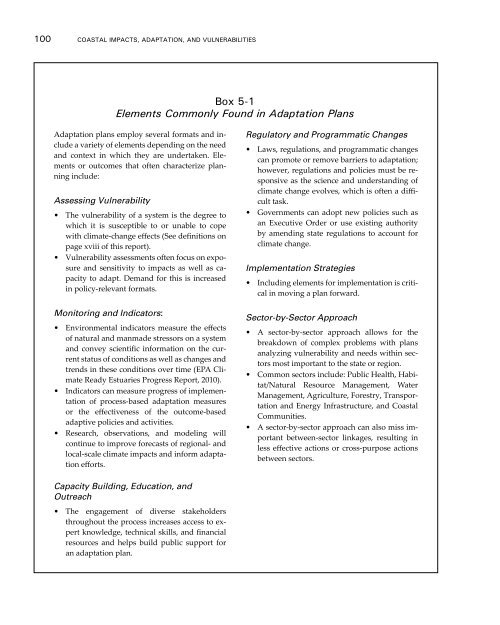Coastal Impacts, Adaptation, and Vulnerabilities - Climate ...
Coastal Impacts, Adaptation, and Vulnerabilities - Climate ...
Coastal Impacts, Adaptation, and Vulnerabilities - Climate ...
Create successful ePaper yourself
Turn your PDF publications into a flip-book with our unique Google optimized e-Paper software.
100 <strong>Coastal</strong> <strong>Impacts</strong>, <strong>Adaptation</strong>, <strong>and</strong> <strong>Vulnerabilities</strong>Box 5-1Elements Commonly Found in <strong>Adaptation</strong> Plans<strong>Adaptation</strong> plans employ several formats <strong>and</strong> includea variety of elements depending on the need<strong>and</strong> context in which they are undertaken. Elementsor outcomes that often characterize planninginclude:Assessing Vulnerability• The vulnerability of a system is the degree towhich it is susceptible to or unable to copewith climate-change effects (See definitions onpage xviii of this report).• Vulnerability assessments often focus on exposure<strong>and</strong> sensitivity to impacts as well as capacityto adapt. Dem<strong>and</strong> for this is increasedin policy-relevant formats.Monitoring <strong>and</strong> Indicators:• Environmental indicators measure the effectsof natural <strong>and</strong> manmade stressors on a system<strong>and</strong> convey scientific information on the currentstatus of conditions as well as changes <strong>and</strong>trends in these conditions over time (EPA <strong>Climate</strong>Ready Estuaries Progress Report, 2010).• Indicators can measure progress of implementationof process-based adaptation measuresor the effectiveness of the outcome-basedadaptive policies <strong>and</strong> activities.• Research, observations, <strong>and</strong> modeling willcontinue to improve forecasts of regional- <strong>and</strong>local-scale climate impacts <strong>and</strong> inform adaptationefforts.Regulatory <strong>and</strong> Programmatic Changes• Laws, regulations, <strong>and</strong> programmatic changescan promote or remove barriers to adaptation;however, regulations <strong>and</strong> policies must be responsiveas the science <strong>and</strong> underst<strong>and</strong>ing ofclimate change evolves, which is often a difficulttask.• Governments can adopt new policies such asan Executive Order or use existing authorityby amending state regulations to account forclimate change.Implementation Strategies• Including elements for implementation is criticalin moving a plan forward.Sector-by-Sector Approach• A sector-by-sector approach allows for thebreakdown of complex problems with plansanalyzing vulnerability <strong>and</strong> needs within sectorsmost important to the state or region.• Common sectors include: Public Health, Habitat/NaturalResource Management, WaterManagement, Agriculture, Forestry, Transportation<strong>and</strong> Energy Infrastructure, <strong>and</strong> <strong>Coastal</strong>Communities.• A sector-by-sector approach can also miss importantbetween-sector linkages, resulting inless effective actions or cross-purpose actionsbetween sectors.Capacity Building, Education, <strong>and</strong>Outreach• The engagement of diverse stakeholdersthroughout the process increases access to expertknowledge, technical skills, <strong>and</strong> financialresources <strong>and</strong> helps build public support foran adaptation plan.
















